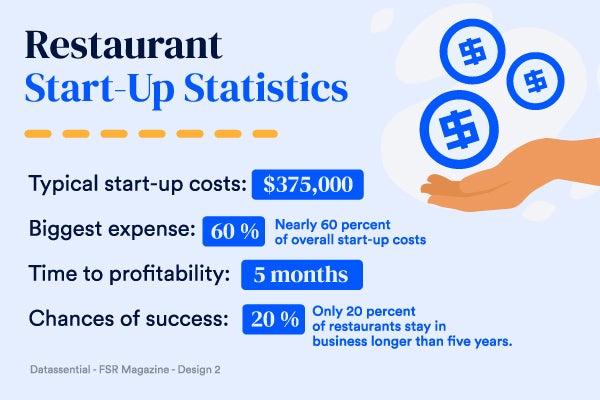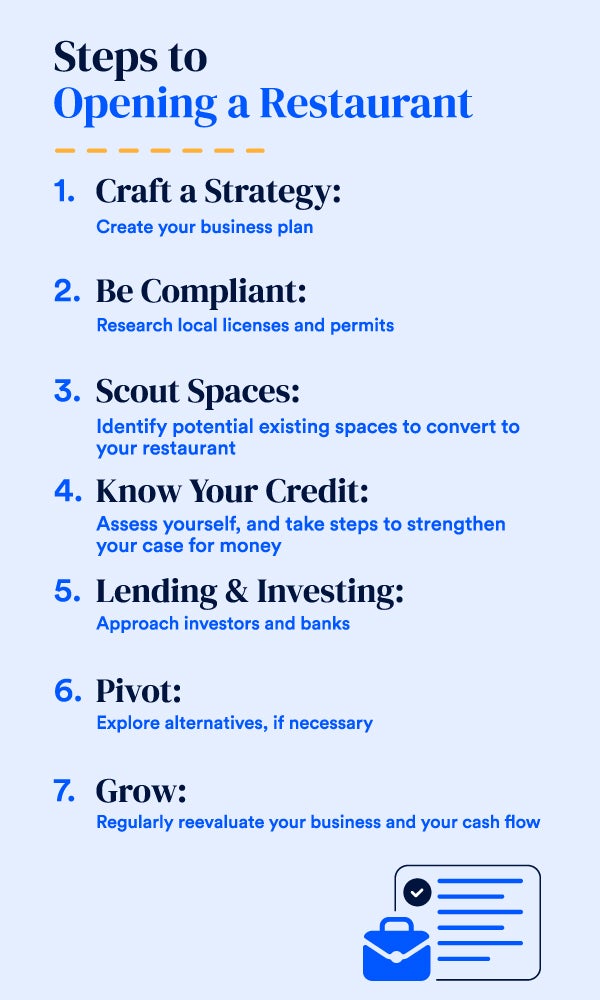From Bankrate.com By David McMillin
If you want to open a restaurant, you’re going to need to open your wallet.
The median restaurant startup cost was $375,000 in 2018, according to a survey of 350 independent restaurant owners and operators conducted by RestaurantOwner.com. That initial investment includes a wide range of expenses: construction to build the space, equipment for the kitchen, insurance, pre-opening costs to promote it and more.
Some of those restaurants managed to turn a profit – the median restaurant took five months to be profitable while more expensive restaurants took a year to get out of the red – but all of them felt the devastation of the coronavirus pandemic. Statistics from Datassential, a foodservice research firm, show that nearly 80,000 restaurants in the U.S. have closed permanently since March 2020. For those who managed to stay open, restaurant and food service sales fell by $240 billion in 2020, according to the National Restaurant Association.

As the number of vaccinations rises and the number of COVID-19 cases declines, though, the restaurant industry is poised for a rebound. With many people tired of cooking at home, is now the time to think about opening the doors of a new restaurant?
Create a business plan
In addition to creating the recipes for the dishes you’ll serve, you will need to create a recipe for the overall restaurant. Sit down and create a comprehensive business plan that turns your idea into a tangible concept. This means articulating a wide range of details including:
- The type of food you’ll serve.
- The pricing structure for food and drinks.
- The type of customers you hope to attract.
- The marketing plan for reaching those customers.
- The number of employees you’ll hire.
- The outlook for the neighborhood where your restaurant will be located.
As you start your business plan, look for helpful resources in your city. For example, Chicago offers a restaurant startup program to guide aspiring restaurant owners through the process, including a sample business plan that can serve as a starting point.
While every business plan will look different for opening a restaurant, one element feels like a must-have piece for success in the post-pandemic era of eating.
“The future would appear to include off-premise dining, like delivery and takeout,” Sharokina Shams, vice president of public affairs at the California Restaurant Association, says. “Many restaurants struggled to pivot to a takeout and delivery during the pandemic, but many of those who survived the last year are likely to hang on to these additional service pathways – in addition to on-site dining – as long as guests continue to utilize them.”
As you create a budget for your restaurant, it’s important to take a lesson from budgeting for your personal life, too: You need a buffer of extra cash to help you navigate an unexpected, worst-case scenario. And if the coronavirus financial fallout proved anything, it’s that those unexpected, worst-case scenarios do happen.
Necessary legal permits and licenses
Before you can fill any seats in a restaurant, you need to make sure you’re legally allowed to open your doors. The requirements for business licenses and permits will vary based on the type of restaurant you’re opening and where it’s located, and you may need to obtain these through the state and the city. Some will include:
- Food service license: This will likely come from your local health department and will verify you have the proper sanitation and cleanliness efforts to serve food.
- Sales tax license: This proves that you are licensed to collect sales tax and helps you submit those taxes to the state.
- Liquor license: If you want to serve alcohol at your restaurant, you’ll need to pay for the right to do it. The cost here can vary widely from as low as $100 to more than $13,000, according to data from Ballotpedia.
- Outdoor patio or sidewalk cafe permit: Some municipalities may require an additional permit for serving food and alcohol outside.
- Entertainment permit: If you’re planning on having dancing or live music, you may need to shell out some additional money.
- Music license: Even if you aren’t having a stage or dedicated area for performers, you’ll still want to have a soundtrack. Playing recorded music requires a permit to pay one of the performers’ rights organizations, ASCAP or BMI. Those annual licenses start at just over $1 per day and vary based on the size of your business and the way you plan to use music.
These permits and licenses may require recurring payments, so it’s important to factor these into your continuing business operation budget. For example, liquor licenses often must be renewed every year.
Funding
The high costs of opening a restaurant can make paying for it on your own seem impossible. With that in mind, aspiring restaurant owners can investigate a range of options for securing startup capital to get the kitchen closer to cooking. Before you start asking for money, it’s important to think about how you will look in the eyes of anyone who will consider lending it to you.
“It’s beneficial for aspiring owners to understand their credit profile,” Rob Myers, head of small business relationship banking at Wells Fargo, says. “This includes business practices, banking relationships, past and current financial activity, and even the way they present their financial history and future. Some key elements that can strengthen a credit profile include separating business and personal expenses, showing a strong payment history and demonstrating a consistent flow of funds.”
Explore loans at traditional banks: You’ll need a business checking account for your restaurant, so you will have a relationship with a bank or credit union. However, the odds of a traditional financial institution offering you a big loan for a brand new, unproven business (restaurant or otherwise) are not great. Most business loan options are reserved for businesses that have been operating and profitable for at least two years. You might be able to get approved for a credit card or a smaller line of credit, but that won’t be enough to cover the hundreds of thousands of dollars you need to open a restaurant. Plus, the interest rate may be so high that you will take on too much debt.
Find an investor: While a new restaurant may be deemed a bit risky by a financial institution, you may be able to attract the interest of private investors. You don’t necessarily need a business card of someone at the high levels of a venture capital fund, either. For example, Illinois-based Vintrohelps connect entrepreneurs with more than 800 investors, and the website recently worked with the Illinois Restaurant Association to solicit pitches for restaurant concepts.
“How many great ideas out there never see the light of day because the founder wasn’t born in the right place at the right time or have access to the right network?” asks Noor Sugrue, founder of Vintro. “The success of your idea should be based on the quality of your idea and your ability to nurture it.”
Ask the crowd: Crowdfunding sites like Kickstarter can be an outlet to the money you need for your restaurant, too. Chef David Yoshimura recently managed to raise more than $60,000 in a campaign to launch his restaurant, Nisei, in San Francisco. Crowdfunding is a low-risk option that helps you avoid sinking all of your own capital – although you will likely still need to invest plenty of your own funds – into the idea, and it can be a valuable opportunity to help spread the word well before you open your doors.
Consider lower-cost options
If you can’t secure funding for your own space, don’t despair. There are alternative ways to help get your idea off the ground in a slightly different – and much more affordable – way.
Share your space: Rather than finding someone to pay for your high costs, you may be able to find someone to help significantly lower them. These are often called food incubators, and the mission aims to help people with good culinary concepts test them out without the high overhead of traditional restaurants. For example, La Cocina in San Francisco offers low-income female entrepreneurs subsidized kitchen space, and Fulton Commons in San Francisco offers a $650 per month membership that comes with access to the commercial kitchen and business planning guidance.
Drive a food truck: Since one of the biggest costs of a restaurant is often the actual space, why not just eliminate that big chunk of overhead? While a food truck still comes with plenty of challenges and permits, it is an opportunity to test and refine your menu without being locked into a brick-and-mortar location.
Start a catering business: A catering company can represent another foot in the door for your business idea without the massive overhead. You can test your menu, refine your recipes and get a feel for the pressure of running an actual restaurant. Yoshimura actually spent two years opening temporary pop-up locations of Nisei and catering lunches prior to securing the physical space for the restaurant.
Pivoting to a lower-cost option doesn’t mean your restaurant will never come to life. In fact, the more affordable approach can lay the foundation for a bigger future where you can secure more funding.
“It’s also important to understand where a business is in its credit lifecycle and plan appropriately for financing,” Myers says. “If the business is still in the seed stage where a business plan is being created, this is an excellent time to develop a funding strategy that includes what type of credit will be used. Then, as the business enters the startup and growth stages, different types of financing can become more available and viable. As these options become available, it will be important to work with a financial professional to know what is needed to acquire them.”

Bottom line
Opening a restaurant isn’t easy, and it can seem prohibitively expensive for anyone new to the industry. The pandemic created an even tougher environment for kitchens and dining rooms, too. However, there is hope on the horizon – and a serious hunger in the pit of many people’s stomachs who are longing for the feeling of eating something delicious without cleaning up their own kitchens. In fact, nearly 80 percent of adults say their favorite restaurant foods deliver flavor and tastes that cannot be duplicated at home, according to the National Restaurant Association. Will your concept be the next to add to someone’s list?
As you dream of offering that dining experience, think about how much you need to charge to make your plates profitable.






